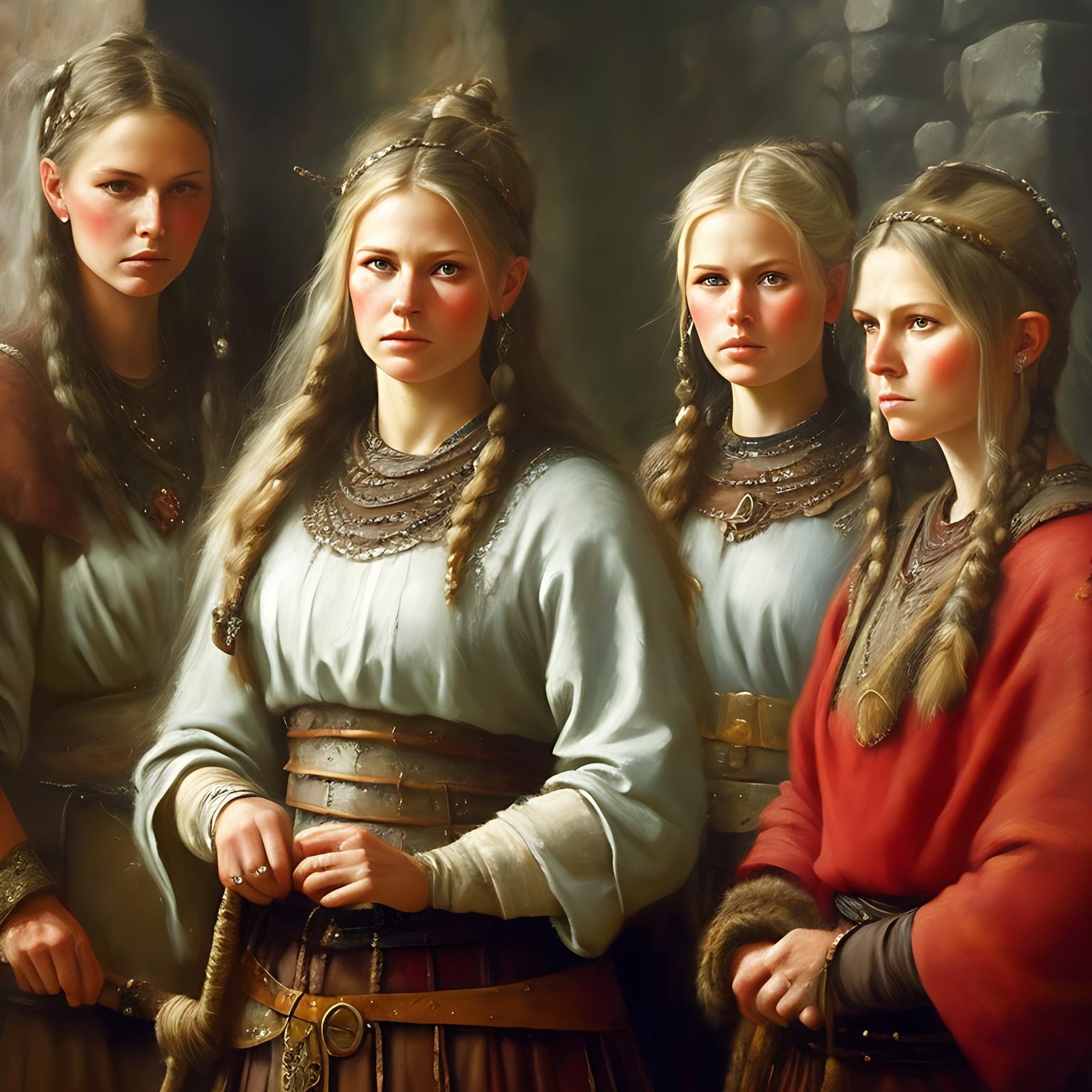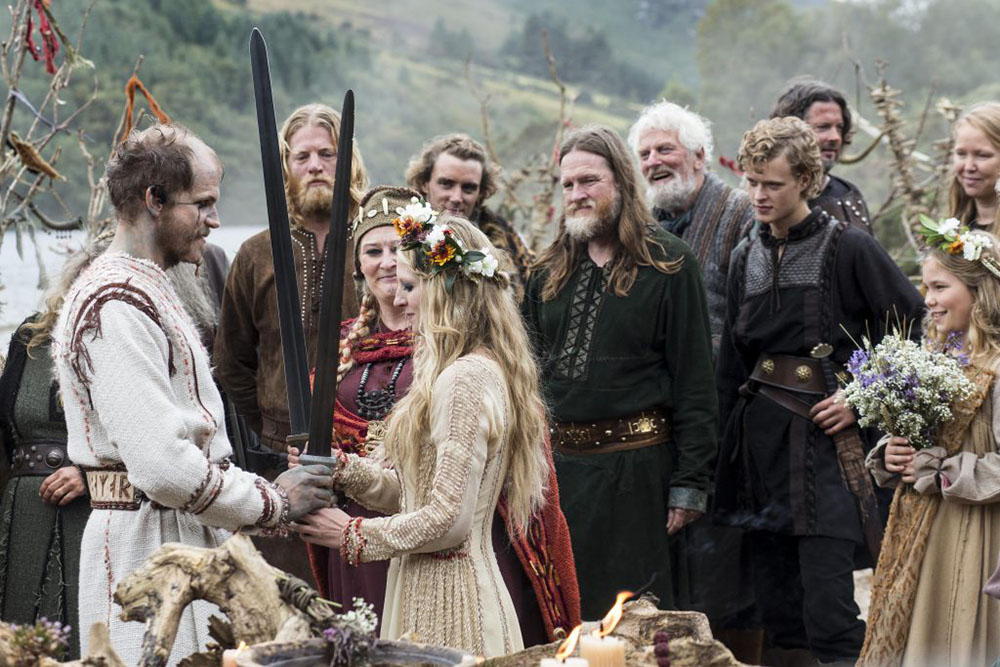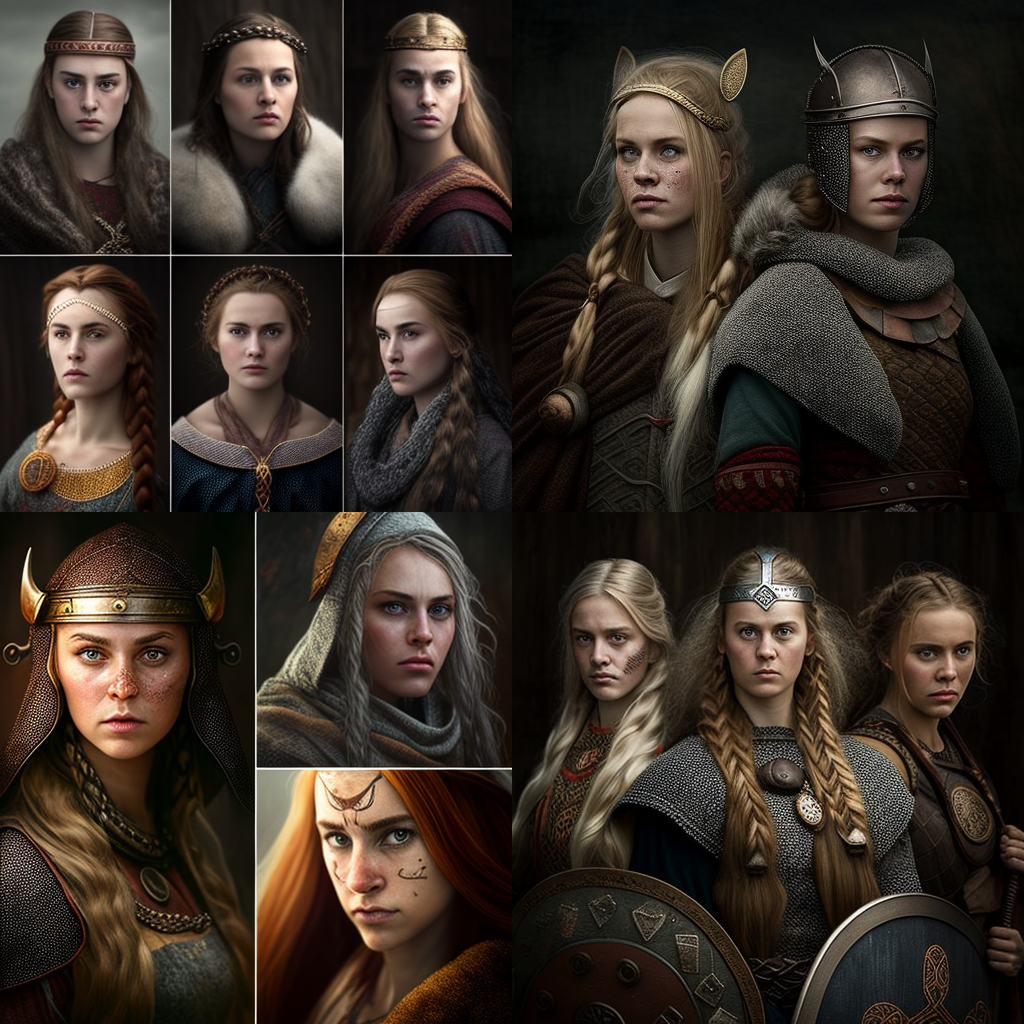Gender Roles: Viking Women during the Middle Ages










Sources

The non-capitalized term Viking can refer to a person going on adventures by sea for wealth and prestige (víkingr) or traveling itself. You then conjure this image of long-haired and bearded men sailing, raiding, and pillaging villages as movies, TV shows, books, and other media would have it. And if you’re going by the rune, víkingr refers to a man. So, where do the Norse women fit in?
This guide weaves women into the grand narrative of the Vikings during the Middle Ages, discussing their roles and contributions in Viking age society.
Table of Contents
Vikings and Gender Roles
The portrayal of Vikings as masculine, intrepid men is very much visible in the media. Eric the Red easily tops any top 10 list of famous and important Vikings, and one would be lucky to find a woman, albeit a legendary shield-maiden named Lagertha, in it.
Nevertheless, gender roles in Viking Age Scandinavia were not as defined as it seems. Keys often taken as a symbol of household management and said to be a woman’s domain were found in men’s graves as well. It’s inferred that keys (like other material possessions found in excavated remains) were buried with Vikings for practical and symbolic reasons.
Why Study Viking Women and Gender Roles
The nuances of supposed deviations such as those discussed above make studying gender roles in history important. In this case, this is further underlined by the perception that little reporting exists about women during the Viking Age, or at least that they don’t enjoy the level of exposure that their male counterparts do in pop culture.
Studying gender roles in history is one way to determine any remarkable changes in human society. How different or similar were scandinavian women then versus women today? What was it like for a woman living during that time, given the context of the Viking world?
The Viking Age, Briefly
The Viking Age refers to the time when people from the North, or Norsemen, raided, invaded, traded, or traveled to foreign territories from Europe to Central Asia and even North America. These people were broadly referred to as Vikings.
In England, for example, the Vikings attacked Lindisfarne, an important early Christian center. The Viking raid at Lindisfarne in 793 was one of the most notable Viking raids.
Some Viking attacks went as far back as 570 in Frisia. Nonetheless, the Viking Age is conventionally placed from the 8th to 11th century. The period also came to be applied to territories where the Vikings were, be it Scandinavia or places they settled in, like England, France, Scotland, Iceland, and Greenland.
Inwardly, the Viking Age saw the consolidation of kingdoms, as in the case of Denmark. As selecting rulers took on a clearer process, and as Christianity was widely accepted as a religion, the Viking Age reportedly ended.
The Viking king (the king of Norway) lost to King Harold II Godwinson at the Battle of Stamford Bridge. This event also contributed to the end of the era. The Viking way of life also ceased as the seafarers integrated into their new environments.
The Role of Viking Women in Society
The Viking society consisted of three classes:
- Elites – jarl or earl
- Peasants and farmers – Karl
- Slaves – thrall
It was believed that seeking out women for marriage was one of the reasons that the Viking armies raided or went on expeditions, or that they sought fortune in foreign lands to make themselves more “marriageable” to such women back home.
Female burials discovered in Viking lands reveal that many women lived structured lives tied to family and economic responsibilities. In some cases, a woman buried with artifacts indicates status or importance.
Family Life and Marriage

Exchange of swords as depicted from Vikings TV Series
Marriages during Viking times were characterized as a contract between couples, and by extension, their families. It was a strategic alliance consolidating wealth and power or securing peace among clans.
A Viking marriage consisted of a betrothal and a wedding. The would-be groom would pay mundr, or the bride price, to the family of the bride. And the bride’s family gave a dowry to the groom’s family.
A Viking woman had a say on the marriage in so far as being consulted about it before the family, usually the father, made a decision. She could probably say no, although not without consequences.
Vikings married young; a woman could get married at 12. This fulfilled the purpose of marriage as a way to procreate.
Divorce was also permissible in Viking Scandinavia. A woman could end her marriage on the grounds of domestic abuse, neglect, childlessness, etc., with a straightforward process of declaring herself divorced before witnesses. Young children would go to the woman, who also kept the dowry and property indicated in the marriage contract and divorce settlement.
Household Management and Responsibilities
A married Viking couple had joint responsibility to run the household. For example, whilst men tilled the land, women’s roles involved preparing food and managing family resources.
A Viking farm had a longhouse, a wooden structure that served as the main building and lodging for the family members, slaves, and animals. It was usual for everyone to carry out chores or to help out on the farm.
Economic Participation
Vikings mostly lived in villages consisting of farms. Aside from subsistence farming, Norse women were involved in weaving and other crafts. They might have even made money from textiles, contributing to the overall prosperity of Scandinavian society. They were also engaged in fishing and trading, which included the goods they collected from their exploits abroad.
The farm was a hub of activity, and women joined in growing vegetables, gathering herbs, helping out in harvests, raising animals, performing milking and dairy-related chores, ensuring food stores were well-stocked, and keeping the house and farm in order, essentially. There were variances in farm work depending on the social class.
Women did weaving and made clothing for themselves and their families. They might even have made money out of the textiles they produced.
In the stead of their husbands, housewives took charge of the farm and engaged in trade. The possibility of women being tradesfolk surfaced when scales and implements used by merchants were found buried with them.
Religious and Spiritual Roles
In paganism, there is a seeress who foretells the future, heals the sick, offers blessings, etc. She uses seid or seidr, which refers to a type of Old Norse magic.
The role of völva was reserved to women due to societal norms, which did not really stop men from practicing magical rituals. Revered or scorned (with black magic and curses), the seeress held a spiritual role in the Viking Age. Perhaps a queen or other powerful women held roles in guiding their communities, whether through supernatural means or administrative control.
The existence of this prophetess is based on sagas and archaeological finds (grave goods).
Military and Political Participation
Power primarily resided with the males among the Vikings. Iceland’s AlÞing, for one, was an assembly consisting of freemen or chieftains. The assembly presided over political and related issues.
With little to no say in political matters, including making laws, women wielded influence in the household. The death of a husband and son could result in them heading their household.
This happened to Unn the Deep-Minded, who gained full control of her household and helmed the ship that took her and her crew to Iceland. Women, by the way, did form part of a Viking ship’s crew.
The warrior unearthed in an important Viking trade center of Birka was a woman. The implication of the finding—the warrior was once identified to be a man—put out there not only the possibility of a female Viking warrior but also that she may have been a military commander.
Evidence from Archaeological Finds
Gravesites and Burials
The ancient Vikings carried secrets to their graves and, when unearthed, revealed clues or left more puzzles. Such is the case of these two notable Viking sites related to our study:
- The Oseberg Viking Burial Ship, also known as the Oseberg Ship, was to safely transport two women to the afterlife. The ladies (or at least one of them) were believed to be of importance based on their clothes, as well as the splendor and detail of the 22-meter ship and its contents. The magnificent burial vessel was excavated in Oseberg farm, Norway, in 1904.
- The Birka warrior grave was a chamber grave found in 1878, which was for the wealthy or elite. The initial assumption of the deceased being male underlies the notion that only men could be warriors, and thus a male could have possessed the weaponry found with the body. DNA revealed that the person interred was biologically female.
Artifacts and Personal Belongings
The Oseberg burial site holds personal items believably owned or related to the deceased, like dresses, long combs, and shoes. Add to that textiles, beds, tents, remains of 15 horses, a cart, work sleigh, and the list goes on.
These items offered a window to the world of the high-society Viking women. The Birka grave goods, which included an array of weapons used by warriors at that time, a board game, and two horses, denoted a warrior role or rank.
Viking artifacts were also found in non-burial sites, such as a mountain pass in Norway, where 800 items were found.
Runestones and Inscriptions
A Viking rune stone is primarily used as a memorial for the dead but not necessarily a grave marker. The runic inscription on the stone tells about the honored subject, usually a powerful leader or warrior. Such inscriptions can also be found in rocks and boulders.
There were about 3,000 rune stones erected during the Viking Age, 2,500 of which were found in Sweden. The Jelling runic stone commemorating the Danes becoming Christians was one.
Sagas and Other Written Accounts
Vikings are primarily known for their oral tradition, and sagas serve to document their history and life.
The Icelandic sagas exemplify stories that have survived generations through storytelling. These prose histories written down in the 13th and 14th centuries usually center on heroic deeds, families, and events concerning Icelanders.
As to whether the sagas are entirely real or accurate is hard to say; they are rich sources of information nonetheless.
Laws are also another written source of information about Viking life.
Myths and Misconceptions about Viking Women

Shieldmaidens and Female Warriors
Valkyries in Norse mythology refer to maidens who escorted warriors who died on the battlefield to Valhalla, or the hall of the slain. These “choosers of the slain” wore helmets, spears, and shields.
Quite relatedly, Scandinavian folklore has shield maidens or female warriors who are said to be fighting alongside men. The most famous shield-maiden, as made popular in a Viking-inspired series, is Lagertha. Her story is based on Saxo Grammaticus’s account, which also talked about women warriors.
Clarification: The controversy surrounding the warrior grave in Birka opened up more interpretations and questions about the existence of female warriors in the Viking Age. The researchers who made the claim in 2017 published a reassessment in 2019, discussing their interpretation in more detail.
“Free Love” and Sexual Liberation
One depiction of a Viking woman is a sexual liberal or one who can take up lovers as they please. Couple that belief with the warrior woman archetype, and what arises is a powerful female figure. Interestingly, Freyja, the goddess of love, sex, fertility, and beauty, is the supposed commander of the Valkyries.
Clarification: Extramarital affairs may be present but not the norm during the time. There were law codes discouraging or regulating such acts and sexual relationships.
Passive and Submissive Stereotypes
Others thought female Vikings to be passive and submit fully to the authority of their husbands or male figures in the family in light of arranged marriages.
The obedient wife is a theme of sagas but with a twist in the case of the Gisla saga. Aud, Gisli’s wife, is seen as loyal to her husband yet capable of protecting her family.
Clarification: The man is the head of the household, but the woman helps run it. She can also inherit property or reclaim her dowry after divorce, making the transition easier financially.
Looking Back and Forward (Comparison with Other Cultures)
Pre-Viking Scandinavian Societies
Contemporary Cultures in Europe
Christianity facilitated the Vikings’ integration into greater Europe—they were no longer viewed as uncivilized or heathens. Christianization was a process for Viking Scandinavia that meant merging old beliefs into new ones for some.
Post-Viking Norway, Sweden, and Denmark are countries that rank high in gender equality. Relatedly, these countries are known for their family-friendly policies, such as parental leave.
Divorce is legal in most parts of Europe, and property ownership is for everyone. Women today are in business, politics, and other realms in and outside the home. Except for codified rights, it’s interesting to see some of those things back in the Viking Age.
Legacy and Influence on Gender Roles Today
Women during the Viking Age left a strong impression, evinced by the fierce warrior portrayal in series, films, books, reenactments, and costume plays.
This strong woman extends to the domain of the home, where their power rests on taking care of their family and keeping the house and its affairs in order.
They did not live in an entirely egalitarian world or behave as today’s world perceives them to be, but one could see them as a symbol of empowerment during that time.
Conclusion
You’ve reached the end and learned these important things about women during the Viking Age:
- They were mothers, housewives, household managers, entrepreneurs, warriors (potential), ship crew members, seers, and so on.
- They married young, earliest at age 12, and were probably linked to a shorter lifespan (30 years old to 50 years old). They were consulted about marriage, but consent was not necessary.
- They could divorce their spouses and get a fair share of the property.
- They enjoyed a degree of freedom and independence, depending on their social class and circumstances.
The story of the Vikings is primarily written by foreigners, and with the society itself being male-centric, the “invisibility of women” is somewhat expected. The interpretation of archaeological finds and artifacts may also reveal preconceived bias and need to be re-examined.
As lifelong students, we can do our research, reexamine facts from our end, maybe speculate with evidence, and ask questions. Viking women are real, and we need to dig deeper into their lives back in those times to paint a more realistic picture of them.
References:
- Christensen, C. (2021, October 11). This Is How the Vikings Proposed and Got Married. Scandinavia Facts. https://scandinaviafacts.com/this-is-how-the-vikings-proposed-and-got-married/
- Gender and sexuality in the Viking Age. (n.d.). https://www.stk.uio.no/english/research/pride/gender-and-sexuality-in-the-viking-age.html
- Groeneveld, E. (2023, March 14). Women in the Viking Age. World History Encyclopedia. https://www.worldhistory.org/article/1251/women-in-the-viking-age/
- Hirst, K. K. (2020, February 5). Viking Social Structure. ThoughtCo. https://www.thoughtco.com/viking-social-structure-living-norse-world-173146
- Hurstwic: What Does The Word Viking Mean? (n.d.). http://www.hurstwic.org/history/articles/text/word_viking.htm
- Jesch, J. (n.d.). What does the word “Viking” really mean? The Conversation. https://theconversation.com/what-does-the-word-viking-really-mean-75647
- Pruitt, S. (2023, February 21). What Was Life Like for Women in the Viking Age? HISTORY. https://www.history.com/news/what-was-life-like-for-women-in-the-viking-age
- The Editors of Encyclopaedia Britannica. (2023, February 7). Viking | History, Exploration, Facts, & Maps. Encyclopedia Britannica. https://www.britannica.com/topic/Viking-people
- The Vikings in Britain: a brief history. (n.d.). The Historical Association. https://www.history.org.uk/primary/resource/3867/the-vikings-in-britain-a-brief-history
- Viking Answer Lady Webpage - Courtship, Love and Marriage in Viking Scandinavia. (n.d.). http://www.vikinganswerlady.com/wedding.shtml
- Viking Archaeology - Viking Marriage and Divorce. (n.d.). http://viking.archeurope.info/index.php?page=viking-marriage-and-divorce
- Women. (n.d.). National Museum of Denmark. https://en.natmus.dk/historical-knowledge/denmark/prehistoric-period-until-1050-ad/the-viking-age/the-people/women/
